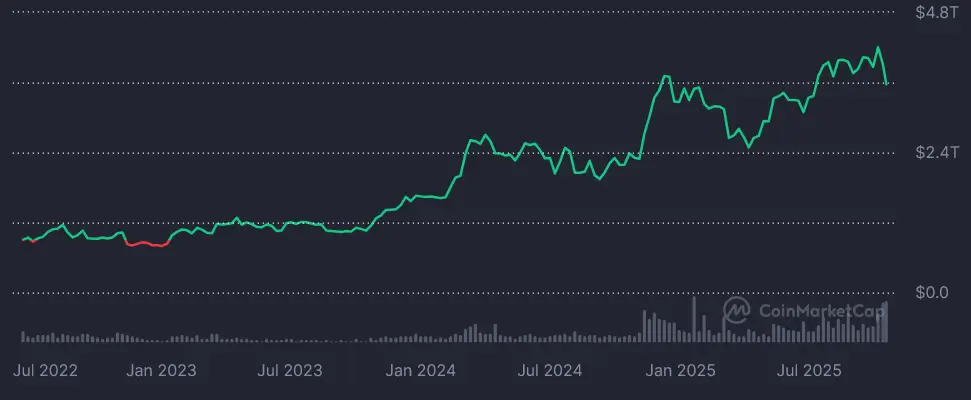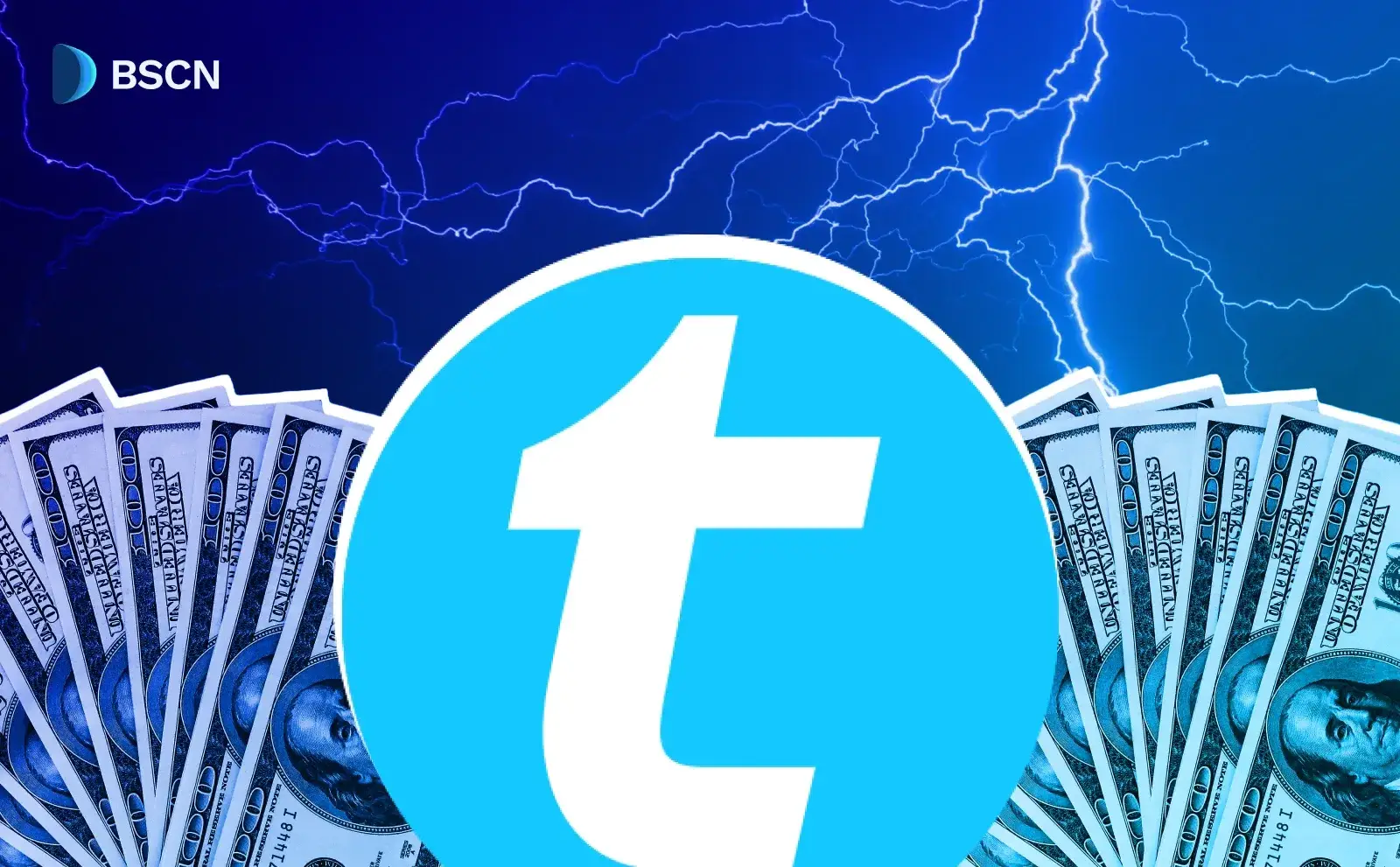Deepdive
(Advertisement)
Crypto Market Cap Explained: A Complete Guide

Learn how crypto market cap works, why it matters for investors, and how to calculate market capitalization for cryptocurrencies and tokens.
Crypto Rich
April 13, 2021
(Advertisement)
Table of Contents
Last revision: October 17, 2025.
Crypto market capitalization measures the total value of a cryptocurrency by multiplying its circulating supply by its current price. This metric helps investors compare different cryptocurrencies and understand their relative size in the market.
Understanding market cap is fundamental to evaluating crypto projects…
How Do You Calculate Crypto Market Cap?
The formula is straightforward: multiply the circulating supply by the current price per unit.
Market Cap = Circulating Supply × Price
Consider two hypothetical tokens. Token A has 50 million coins in circulation priced at $200 each, giving it a market cap of $10 billion. Token B has 5 billion coins in circulation, priced at $2 each, which also equals $10 billion. Despite Token A having a price 100 times higher, both tokens have identical market caps and similar total valuations.
This is why comparing cryptocurrencies by price alone misleads investors. Bitcoin trades at much higher prices than most altcoins, but market cap provides the actual measure of total network value.
Circulating Supply vs. Total Supply
Circulating supply refers to coins currently available in the market. Total supply includes all coins that will ever exist, including those not yet released.
Many cryptocurrencies release coins gradually. Mining, staking rewards, and vesting schedules all contribute to the addition of new coins over time. Bitcoin's circulating supply increases slowly until it reaches its maximum of 21 million coins, expected around 2140.
Some tokens have no maximum supply. Ethereum has no hard cap, though it implements burning mechanisms that remove ETH from circulation.
Why Does Market Cap Matter for Crypto Investors?
Market cap provides context that price cannot. A cryptocurrency trading at $0.01 might seem cheap, but with 100 billion coins in circulation, its market cap is $1 billion, larger than many established projects.
Investors categorize cryptocurrencies by market cap:
- Large-cap cryptocurrencies (over $10 billion): Bitcoin, Ethereum, and other established projects with significant adoption and liquidity
- Mid-cap cryptocurrencies ($1 billion to $10 billion): Established projects with growth potential but higher volatility
- Small-cap cryptocurrencies (under $1 billion): Newer or niche projects with higher risk and potential for significant price movements
Larger market caps generally mean more established projects with greater liquidity and less volatility. Smaller market caps often indicate higher risk but potentially larger gains.
What Is Fully Diluted Valuation in Crypto?
Fully diluted valuation (FDV) calculates what a cryptocurrency's market cap would be if all possible coins were in circulation. This metric uses the maximum or total supply instead of the circulating supply.
FDV = Maximum Supply × Price
Bitcoin has a maximum supply of 21 million coins, with most already in circulation, so its FDV stays close to its market cap. Many newer projects show significant gaps between these metrics.
Understanding the FDV to Market Cap Ratio
Some projects show significant gaps between market cap and FDV. Consider a token with 100 million coins in circulation but a maximum supply of 1 billion. At $5 per token, its market cap is $500 million, but its FDV is $5 billion, 10 times higher.
This gap signals potential dilution as new tokens enter circulation through vesting schedules or emissions, thereby increasing supply. Price typically decreases if demand doesn't grow proportionally.
Projects with high FDV relative to market cap may face downward price pressure as more tokens unlock.
What Is Total Crypto Market Capitalization?
Total crypto market capitalization combines the market caps of all cryptocurrencies. This figure represents the entire industry's value, Bitcoin, altcoins, stablecoins, and tokens across all blockchains.
The total crypto market cap has grown significantly since Bitcoin's creation in 2009. The market took years to reach its first major milestone, experienced substantial growth during bull markets, and contracted during bear markets. This volatility reflects the speculative nature and evolving adoption of cryptocurrency markets.

Market Dominance and Market Share
Bitcoin dominance measures Bitcoin's market cap as a percentage of the total crypto market cap. High Bitcoin dominance (above 50%) means Bitcoin controls a larger share of the market. Low dominance (below 40%) means altcoins collectively hold more value.
Market dominance shifts reflect changing investor sentiment. During bull markets, money often flows from Bitcoin into altcoins, reducing Bitcoin's dominance. During bear markets or periods of uncertainty, investors typically move back into Bitcoin, increasing its dominance.
How Does Crypto Market Cap Compare to Traditional Markets?
Cryptocurrency market cap helps contextualize the industry's size relative to traditional assets.
The total crypto market typically represents a small single-digit percentage of the global stock market. It ranges from roughly one-tenth to one-quarter of gold's total market cap, depending on market conditions. At its peak, the total crypto market cap has approached the individual valuations of the world's largest technology companies.
These comparisons provide perspective on crypto's current adoption. Some analysts use these ratios in their analysis, though projections based on these comparisons remain speculative.
What Are the Limitations of Market Cap?
Market cap has significant limitations as an evaluation tool.
Liquidity: A cryptocurrency might have a high market cap but low trading volume. This makes it difficult to buy or sell large amounts without affecting the price.
Lost or locked coins: Bitcoin's circulating supply includes millions of coins lost forever in inaccessible wallets. These coins inflate the market cap despite being unavailable.
Price manipulation: Low-volume tokens can show inflated market caps through price manipulation on small exchanges.
Stablecoins and wrapped assets: Total crypto market cap includes stablecoins, which represent dollars rather than speculative assets. This can distort comparisons.
Real liquidity: The actual capital needed to achieve a certain market cap is typically far less than the market cap itself. Markets price assets at the margin.
Additional Metrics to Consider
Investors should evaluate multiple metrics alongside market cap:
- Trading volume indicates actual market activity
- Total value locked (TVL) shows capital deployed in DeFi protocols
- Active addresses and transaction counts measure actual usage
- Revenue and fees generated by protocols indicate real economic activity
- Development activity reflects ongoing improvements and community engagement
How Does Market Cap Work Across Crypto Categories?
Different types of cryptocurrencies utilize market cap in varying ways based on their purpose and structure.
Layer-1 blockchains like Bitcoin, Ethereum, and Solana use market cap to measure their security budget and economic bandwidth. Higher market caps generally indicate more robust networks.
DeFi tokens often have market caps that relate to their protocol's TVL. A healthy DeFi protocol typically has TVL higher than its token's market cap.
Memecoins often have high market caps compared to their actual utility or adoption. These valuations rely primarily on speculation and community engagement rather than underlying value.
Stablecoins maintain market caps that reflect the amount of real currency backing them. Major stablecoins like USDT and USDC have market caps in the tens of billions, representing actual dollars held in reserve.
How Should You Use Market Cap in Investment Decisions?
Market cap serves as one component of crypto analysis, not a standalone tool. Effective analysis requires combining market cap with other metrics and contextual factors.
Compare market caps within similar categories. A layer-1 blockchain with a significantly lower market cap than competitors with similar technology and adoption might be undervalued.
Examine the relationship between market cap and other metrics. A DeFi protocol with substantial TVL but a relatively small market cap might offer better value than one with similar TVL but a much larger market cap.
Consider market cap alongside tokenomics. Projects with low current market caps but high FDV face significant dilution risk. This could outweigh apparent undervaluation.
Watch market cap changes over time. Consistent market cap growth alongside increasing usage and adoption indicates healthy development. Market cap growth without corresponding adoption may signal speculation.
Thorough analysis requires examining liquidity, tokenomics, adoption metrics, and protocol fundamentals alongside market cap data.
Sources
- CoinMarketCap - Cryptocurrency Market Capitalizations.
- CoinGecko - Crypto Market Cap Charts.
- Glassnode - Bitcoin Supply Data.
- Blockchain.com - Bitcoin Statistics.
- DefiLlama - DeFI TVL statistics.
Read Next...
Frequently Asked Questions
Is a higher market cap better in crypto?
A higher market cap generally indicates a more established project with greater liquidity and less volatility, but it doesn't guarantee better returns. Smaller market cap projects carry higher risk but may offer larger potential gains.
What's the difference between market cap and fully diluted valuation?
Market cap uses circulating supply, while fully diluted valuation (FDV) uses maximum supply. FDV shows what market cap would be if all possible coins were in circulation, helping investors assess future dilution risk.
Can market cap be manipulated in crypto?
Yes, particularly in low-volume tokens. Price manipulation on small exchanges can create artificially high market caps. Investors should verify trading volume and liquidity alongside market cap to identify legitimate valuations.
Disclaimer
Disclaimer: The views expressed in this article do not necessarily represent the views of BSCN. The information provided in this article is for educational and entertainment purposes only and should not be construed as investment advice, or advice of any kind. BSCN assumes no responsibility for any investment decisions made based on the information provided in this article. If you believe that the article should be amended, please reach out to the BSCN team by emailing [email protected].
Author
 Crypto Rich
Crypto RichRich has been researching cryptocurrency and blockchain technology for eight years and has served as a senior analyst at BSCN since its founding in 2020. He focuses on fundamental analysis of early-stage crypto projects and tokens and has published in-depth research reports on over 200 emerging protocols. Rich also writes about broader technology and scientific trends and maintains active involvement in the crypto community through X/Twitter Spaces, and leading industry events.
(Advertisement)
Latest News
(Advertisement)
Crypto Project & Token Reviews
Project & Token Reviews
Comprehensive reviews of crypto's most interesting projects and assets
Learn about the hottest projects & tokens

















